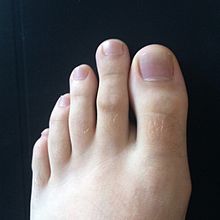Morton’s toe is a common forefoot disorder. A person with Morton’s toe has a second toe that is longer than their big toe. Since the joint of this toe is placed in the lead position (instead of the big toe); this toe joint becomes the weight-bearing joint during the propulsion phase of the gait cycle. Therefore, excessive pressure is placed on the second metatarsal joint in the ball of the foot, resulting in pain similar to the discomfort associated with metatarsalgia. This constant pressure can result in:
- Heavy calluses that form under the second metatarsal joint
- The breakdown of the joint structure
- The biomechanical dysfunction of the foot
Note: Morton’s toe is often confused with Morton’s neuroma which is a different condition.
Cause
Morton’s toe is an inherited foot condition.
Treatment
Proper treatment for Morton’s toe starts with a custom-fitted ezWalker® orthotic device to redirect the loading force of the foot onto the big toe joint for a proper biomechanical step. It may be necessary to use a Morton’s toe extender to achieve complete redistribution of weight to the big toe. This is a firm, lightweight plate added to the ezWalker® Custom Performance Orthotic to give more loading power to the big toe.
Also, a shoe with a broader toe box is recommended to allow better placement of the big toe within the shoe. Over time the metatarsal joint of the longer second toe can become stiff and lose mobility. In this case, a shoe with a rocker toe is recommended to reduce stress on the joint and ease gait.
Our feet are constantly changing throughout life. You should have your shoe fit checked regularly. And remember, the size on the measuring device is only a reference. Mass-manufactured shoes are NOT all created equal. Refer to the Shoe Fitting Reference Guide for proper guidelines on how to best fit your shoes.
Note: If you follow these guidelines and your pain persists, you should see a physician for proper diagnosis and treatment. If Morton’s toe pain is left untreated, it can lead to a serious breakdown of the joint structure, leading to a lack of mobility and arthritis conditions.

